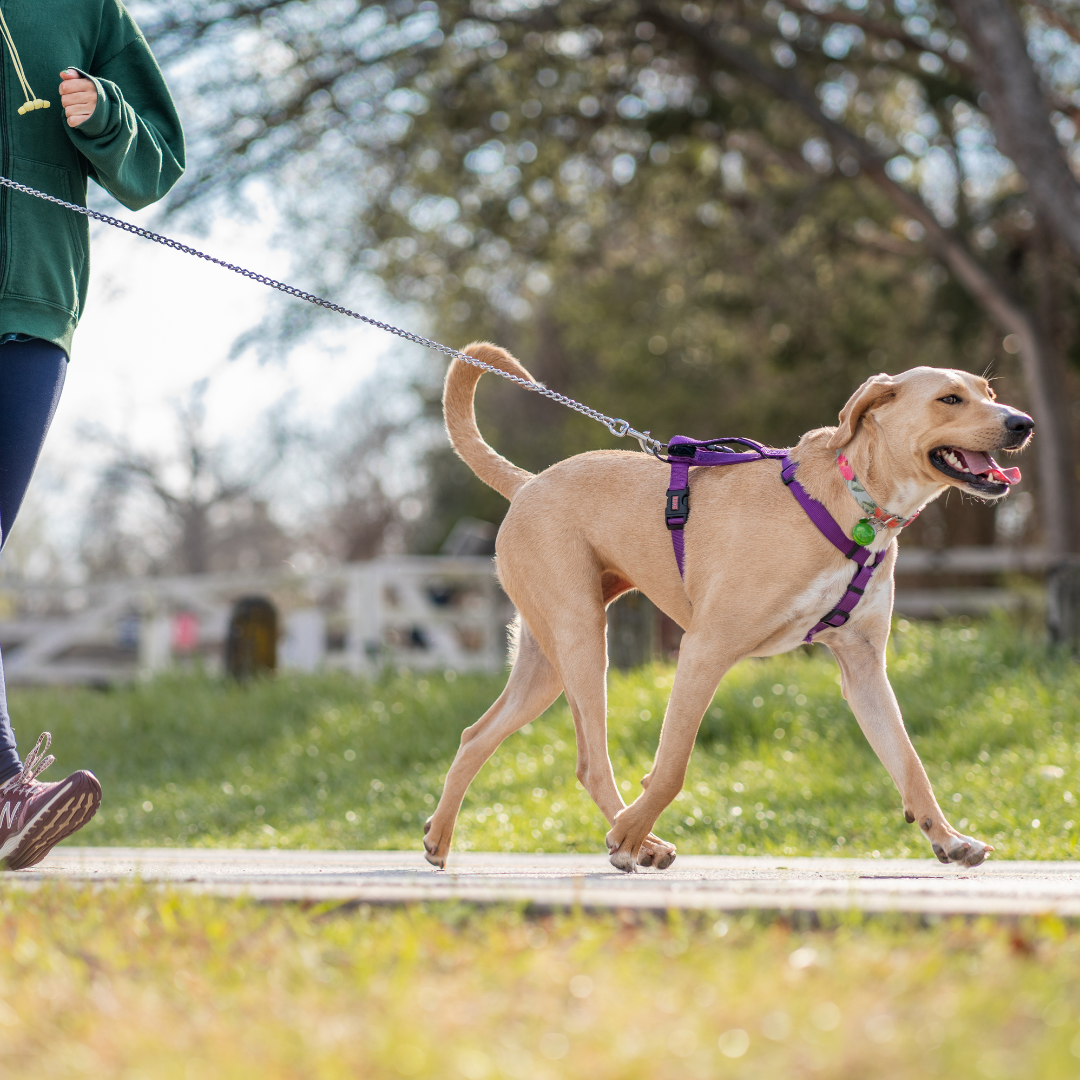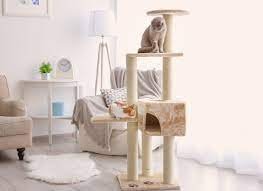
Blog
Asking For A Fur-Friend
Tips for Running With Your Dog
Running with your dog is a fun way to spend time together and helps keep both you and your pup in shape. Canine fitness is an important part of their overall health. Plus, having a cute furry running buddy can be that extra motivation you may need. Before diving into running with your dog, there are some things you need to consider.
Running with your dog is a fun way to spend time together and helps keep both you and your pup in shape. Canine fitness is an important part of their overall health. Plus, having a cute furry running buddy can be that extra motivation you may need. Before diving into running with your dog, there are some things you need to consider.
Before embarking (oh, pun!) on your running journey with your dog, make sure your dog's breed is one that is suited for running. Some dogs, such as brachycephalic dogs, dogs with short snouts, are not meant to be running buddies. Another important thing to consider is your pup's age. Puppies and dogs under one to one and a half years should not be doing long distances. The rule of thumb is to allow your dog to be fully grown to avoid any injury or stress to their growing skeleton. Even if you have a breed who is good at running such as a Vizsla, Dalmatian or even a Terrier or Sheltie, you still need to know that each dog is different and some may decide they do not enjoy running distances. The last major thing to consider would be the health of your dog, certain breeds are known for hip dysplasia and it is always a good idea to get your pup checked by their veterinarian and make sure they are cleared for vigorous exercise.
Before your dog gets into running, your dog must be loose-leash trained. A canine companion who pulls on a leash when walking is annoying, but dangerous if you are running. The outdoors are a fun place with lots of distractions and smells for your pup, but they need to be able to ignore those stimuli and focus on walking with you before beginning to run. Always use positive reinforcement when training your dog; praise, treats and toys can be great rewards for your dog.
Now that your dog is walking nicely by your side on a loose-leash, it is time to begin slowly building your dog’s endurance. Just as humans need to build endurance and strength, so do our dogs. Start by adding small stretches of running into your walks. On each walk, you want to increase the time or distance you spend running and decrease the time spent walking. After several weeks your dog will be in tip-top shape and adapted to running long distances. Running with your dog requires a lot of dedication from both of you. Our dogs love rituals so once your runs are in place, your pet will start looking for how they are added into their daily routines. Consider equipping yourself and your pup with items that are for your run only. Get a running harness for your pup and a two to three meter leash with reflectors. If you would like to have a hands free run, there are body straps or cross-body leashes that are safe to use while running.
Dedicated runners will head out for a run despite temperatures, but if you are running with your dog, you do need to consider the weather before heading out. Dogs should really be run between about 15 and 60 degrees Fahrenheit. During the summer consider early morning or late evening runs or find a place with lots of shade and always make sure you have plenty of water for both you and your pup. In colder temperatures or when there is salt on the ground, consider training your dog to run in booties. These keep their paws safe from the cold, but are also great in the summer when the pavement is hot. If the weather is not permissible for a run, give your dog the exercise they need with vigorous indoor play. A game of fetch down a long hallway or up and down a flight of carpeted stairs can be a great way for your dog to get their run indoors.
Dogs are our companions and we want to include them in as much of our lives as possible. It is important to do so safely; running can be a great bonding experience for you and your pup.
If your pup is on a schedule and you are away, consider hiring a professional pet sitter to visit and give your pup a good walk and some of the exercise they need. If you are located in the Naperville, Elmhurst, Lombard or Villa Park, IL area, call The Pet Lady at 847.802.9534 or contact us here.
Tips for Conducting a Pet Sitter Interview
Just as much as you are interviewing a potential pet sitter, they are interviewing you as well. You always want to make sure to thoroughly vet your pet sitter and make sure they will be a good fit for your pet and for you. Each pet sitter and pet sitting company probably operates a bit differently from each other, as there is no right way to run a pet sitting company, but there are some basics that should be in place when selecting a pet sitter.
Just as much as you are interviewing a potential pet sitter, they are interviewing you as well. You always want to make sure to thoroughly vet your pet sitter and make sure they will be a good fit for your pet and for you. Each pet sitter and pet sitting company probably operates a bit differently from each other, as there is no right way to run a pet sitting company, but there are some basics that should be in place when selecting a pet sitter.
There is no one size fits all for pet sitters, as some specialize in just cats or just dogs, or even provide care to exotic pets and livestock. With the boom of on demand pet sitters through apps like Wag and Rover, you will need to be more prudent than ever in your search to find a reliable pet sitter. You must set aside time and realize that it may take time and even a few phone interviews until you find someone or a company who would be a good fit.
Before leaving your pet in the care of a pet sitter or dog walker there should always be an initial meeting, called a ‘meet and greet’ or ‘consultation’. This is as much an opportunity for you to interview the potential pet sitter as well as an opportunity for them to interview you and your pets. This also gives the pet sitter a chance to meet your pets in their home and interact with them. There are many times I arrive at a meet and greet and I hear ‘Wow, Fifi is connecting with you more than the other person we interviewed’. For me this is a good sign, not only does it indicate to me that the dog is a good fit, but the owner is too. They are taking the time and putting in the effort to find the right fit for Fifi. While The Pet Lady provides a free meet and greet for all potential clients, it is not uncommon for a company or person to charge for a meet and greet or consultation.
We will discuss a few important questions you should be asking your potential pet sitter or dog walker next, but please note that Pet Sitters International has a great free download checklist of the top seven questions you should be asking your pet sitter in an interview on their website, www.petsit.com.
The first one I will touch on is a combination of two of PSI’s most important questions to ask. Licensing, insurance and bonding. Sounds fun, right? Well, it is important to ask these questions, fun or not, as you need to know if you, your pet, or the pet sitter is covered in an emergency. Things happen and we need to be PUPared for them. Also, certain states, cities and jurisdictions require different business documents, so you should familiarize yourself with what may be required in your area.
The second one I will touch on is can the person or company provide references. For example, The Pet Lady asks our clients for feedback on Google, there many companies will get reviews and these are viewable to the public. If there is a negative review, how does the person or company handle the situation? Beyond that, can the person or company provide current clients who can provide references.
Another thing I get asked a lot: is there a contract we need to sign. The Pet Lady does have all clients sign a service contract. This lays out what the duties of the company are in terms of care of pets and the client's home as well as what the expectation of the client is. This is an important thing to ask, so the person or company can provide you with all details. For example, if you want your pet sitter to arrive at dinner time to feed Fluffy, for one company that may be 4pm and another may be 6pm. Contracts and service agreements lay out the time frames for those services. The Pet Lady provides our dinner visits between 4pm and 530pm.
A great thing to bring up in your pet sitter interview is if the person or pet sitter has any specialized training or is a member of an educational association. I am a Certified Professional Pet Sitter, this means I have taken the time to learn and study all aspects of the industry from the business side to the pet side and have completed a course and test. This also means I am committed to continued education to keep my certificate active. This is a great way to learn more about your pet sitter and their passions within the industry. Hiring a pet sitter who is a member of an organization such as Pet Sitters International or the National Association of Professional Pet Sitters demonstrates the pet sitter’s commitment to the job and industry at large. These professional organizations provide educational resources and business tools to help their members provide the best possible services to pets and their owners.
Other considerations to take into account would be things like how much notice the sitter needs in order to schedule a service request from you. Some sitters will take last minute bookings, while others require a specific notice. Does the pet sitter have office hours and when will emails, texts and messages be answered? Most sitters and companies, while they work long hours, only are available to answer questions during specific hours of the day.
One of the most important things I mention to all clients are our emergency policies and this is something I highly recommend you ask your potential pet sitter. What if they are sick or their car breaks down? What if your pet needs medical attention? Or depending on the area you live in, what if a natural disaster occurs? While each sitter and pet sitting company is different, they should all have policies in place for if emergencies happen. The Pet Lady employs staff who pride themselves on working as a team when emergencies arise.
While a lot of these questions can sometimes be answered on the sitter's or company's website, it is good to review these things during your interview. The potential pet sitter will have questions for you regarding care of your pets and your home as well. According to PSI “When you engage the services of a professional pet sitter, [...] make sure all your questions are answered to your satisfaction. This ensures that you can leave your beloved pets with the peace of mind knowing that they will be well cared for. That’s a win-win-win situation for you, your pets and your pet sitter.
If you are in need of pet care, consider hiring a professional pet sitter in your area. If you are located in Naperville, Elmhurst, Villa Park or Lombard, IL, we would love to meet your furry friends! You can contact The Pet Lady here or call 847.802.9534
Why Do Cats Like to Sleep up High?
We all know cats can be fussy creatures and this attitude extends to their sleeping habits as well. Many owners have gone out and bought plush, expensive beds only for their pampered cats to refuse to sleep on them. Are they just being fussy or is there an ulterior motive for this behavior?
We all know cats can be fussy creatures and this attitude extends to their sleeping habits as well. Many owners have gone out and bought plush, expensive beds only for their pampered cats to refuse to sleep on them. Are they just being fussy or is there an ulterior motive for this behavior?
Whether it’s the top of the refrigerator, a cat perch, the highest shelf on a bookcase, or the top of the cushions on the couch most cats enjoy being in high places and cherish those elevated locations. Your cat may feel more comfortable in the upper half of the room where they can keep an eye on the world around and below them with greater confidence. Instinct plays a huge role in determining feline habits and most cats prefer to sleep and hang out in places with good vantage points. This comes from their instinct to protect themselves and being up high gives cats the advantage of spotting potential dangers. Much of this comes from their ancestors since early cats were hunters that lived in the wild, and their ability to climb meant they had somewhere to retreat to away from larger predators in addition to giving them the ability to hunt for their prey high in the branches. Since this instinct has been passed down, this is why climbing and being up high is natural for our cats.
Cats may also prefer small, enclosed places, especially when sleeping. This also comes from their instinct to feel protected. Many cats, including my own, love to sleep in boxes that are enclosed on all sides. My cats even love it when I close the top, they can still get out, but they get some peace and quiet.
Once your cat finds the perfect place to sleep, they may be happy there for a bit. But do not be surprised if after a few months your cat switches places. The reason for this is only speculation, but experts think that it is driven by the fact that cats are notoriously clean animals; they dislike dust, dirt and even saturated smells. So if the area in which they were sleeping becomes too dirty or the scent changes, they will probably begin their hunt for their new favorite spot.
Let’s dive into details on some of the reasons our cats love elevated perches.
More Visual Warning Time for Your Cat
When your cat is perched high they can easily see more of their environment. The ability to see an opponent or predator entering the area can provide your cat with enough time to plan their escape, remain quiet and hidden, prepare an attack or determine the threat level of the approaching animal or human.
A Way for a Cat to Display Status
In a multicat environment, a higher ranking cat may choose the highest elevated location to display their position within a grouping. When there is tension between cats, the higher ranking cat may assume an elevated position to show status which can thwart off a cat fight.
Out of Reach
If you have a household with cats along with dogs or children, the ability for your cat to retreat to a high perch is the best way for them to be left alone. They may find a place where people and dogs cannot reach them and they can nap in peace.
Exercise and Playtime
If you have a cat tree that has multiple perches, this allows your cat the benefit of being able to climb, jump, and play on the structure. This can be even more true for an indoor cat. Placing a cat tree near a window is the perfect spot for your cat to keep an eye on prey activity happening outside. Even though they won't be able to get to the prey, it becomes a form of cat TV for your feline friend.
Warmth
Even warm and cozy beds can become a chilly place for our cats if placed on the floor. The floor can be drafty and chilly for your feline friend. Perches and beds located on top of cat trees or elevated off the floor are farther from the draft and closer to the rising warm air.
Choosing the Right Perch or Tree for Your Cat
While cat-specific furniture is becoming more and more popular, most of those are made to please the human eye and are less likely to take felines into account in the design. Perches need to be large enough for your kitty to sit on without having their back end or a leg hanging off. If your cat cannot fit on their perch or tree, they may feel it’s a vulnerable spot and may not enjoy being in that spot. Trees and perches that are “U” shaped or have a lip are great since your cat can lean against it. This can give your cat a sense of being protected, having their back up to a wall or ledge. Always take your cat's size and the way they enjoy curling up to nap into account when purchasing trees and perches.
Accommodate Seniors and Mobility Challenged Cats
Your cat should be able to enjoy perches and trees throughout their life. Provide steps for cats who cannot reach perches or other favorite locations. Look for cat trees with lots of platforms and perches so your cat can use them as steps to reach their favorite position on the tree.
Cats sleep a lot. Most cats will sleep up to sixteen hours a day, so make sure they have somewhere cozy and a place they feel safe to relax and nap.
If you are looking for care for your cats while you are away, consider hiring a professional pet sitter. If you are located in the Naperville, Elmhurst, Villa Park or Lombard, IL communities give The Pet Lady a call at 847.802.9534.
Fireworks and Pets
Fireworks have become a staple of this holiday and many others in the US. In the United States our 4th of July holiday is the number 1 day, more than any other day of the year, where the most pets go missing. It is really a sad thing for me to be saying. This is just one reason why it is always a fantastic idea to have your pet microchipped with up to date contact information as well as ID tags with up to date information on your pets at all times.
Fireworks have become a staple of this holiday and many others in the US. In the United States our 4th of July holiday is the number 1 day, more than any other day of the year, where the most pets go missing. It is really a sad thing for me to be saying. This is just one reason why it is always a fantastic idea to have your pet microchipped with up to date contact information as well as ID tags with up to date information on your pets at all times.
So let's talk a bit about why fireworks are so scary for pets.
First and foremost they are loud! Dogs and cats' hearing is much more acute than ours and they can hear sounds from much further away. Just like your dog may know before you do that a thunderstorm is coming, it is the same idea. So when there are loud booms, crackles and whistles, it can be very alarming for your pet.
Fireworks are unpredictable. As humans we know holidays such as new years, independence days and many more will have fireworks so we can be prepared. To our pets it is just another day and those fireworks come with no warning. The loud noises and flashes of lights sound and look different each time, plus come at varying intervals, so dogs and cats cannot get used to them.
Fireworks can pose a threat. The noise and unpredictability of fireworks leads many dogs to perceive them as a threat. This triggers their fight-or-flight response. Your dog may bark at the noises or try to run away and hide. He may show other signs of anxiety, too, like restlessness, panting, pacing and whining.
Fireworks can make your pet feel trapped. Fireworks are inescapable on holidays like Independence Day. So if the noises trigger your dog’s flight response, he will try to run from the threat. Unfortunately, there’s often nowhere to go, as you can still hear those loud booms indoors. This is why some pets such as indoor cats may try to escape outside to find a place they cannot hear them or a dog in a fenced yard may break free.
As you can see, pets have good reasons to fear fireworks. Fortunately, there are several things you can do to help your pet feel safe and secure.
Keep your pets indoors, even outdoor pets. Even if your dog spends most of his time outdoors or you have an indoor/outdoor cat, bring him inside during firework displays. This will prevent him from running away when he feels scared, which can put him in danger.
Give your pet a safe place to go to when they get scared. If your dog is crate-trained, make his crate available, as that’s probably already a safe space for him. If not, put him in a bathroom or other small room with music or white noise to help drown out the boom of fireworks. Bringing his bed, blankets and toys into the room can make him feel more comfortable.
Try a calming wrap or thundershirt. Calming wraps, vests and shirts apply light, constant pressure. Many dogs and cats find this soothing and calming. You may find such products help in other anxiety-inducing situations, like thunderstorms. While this does not work for my dog, I do know people who have had great success with products like this.
You can try to desensitize your pet. Start working with your dog far enough in advance to desensitize him to fireworks and other loud noises. You can start this process by playing fireworks sounds on a low level while playing with your dog and giving him treats. Over time, slowly increase the sound of the fireworks during these play sessions. Eventually, your dog will associate the sound of fireworks with fun and play. You have to be very careful with this, and it takes a lot of time. You cannot rush desensitizing your pet to loud noises as it could make things worse for both them and you.
Walk your pet early in the day. If you know there will be fireworks on a particular day, they typically do not start until the sun begins to go down. Take time earlier in the day and give your dog a good long walk, this can help tire them out before celebrations begin.
Not all pets are afraid of fireworks, but it’s important to remember your pet will take cues from you. If you make a big deal out of them when he’s not scared, he may eventually develop anxiety about fireworks. So make an effort to keep your pet calm, but remember to remain calm yourself. When you understand why pets are scared of fireworks, you can better address your pet’s fears and help him stay calm.









